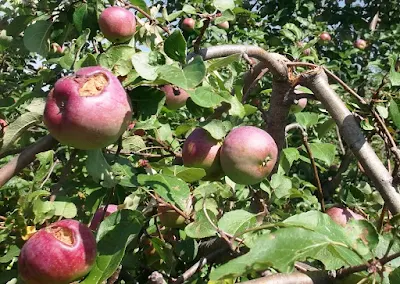 |
| Liberty apples. Bird damage on two apples on left side of picture. Broken limbs in upper right corner. |
 |
| Compare the color of these apples to the color of the ones in the first picture. These apples are about half the size of the red ones in the first picture. |
The fruit that is inside the canopy is smaller and greener. It will never have the quality of the apples on the outside of the canopy, the ones that are supported by leaves that have an uncontested "look" at the sun.
 |
| Bottom portion of picture shows branches that have been pruned from the tree. Nearly all of these trimmings were from the bottom, i.e. the shady side, of the tree. |
They are dead weight. The easiest way to thin those apples is to prune the branches.
One flaw that Liberty has as a variety is short fruit stems. There is not enough room for multiple fruit to ripen. The expanding fruit will cause a significant amount of early drop.
Shaking the branches can help thin the fruit although it tends to dislodge the largest, most advantageously placed fruit.
 |
| Another X frame. If you look closely on the left arm, about eight inches from the top there is a line of baling twine dropping down to support another branch. |
| This man is Ron Perry. He is a displaced California guy. This is the rootstock guru at Michigan State University. |
I think most home orchardist will stick with traditional trees.


No comments:
Post a Comment
Readers who are willing to comment make this a better blog. Civil dialog is a valuable thing.